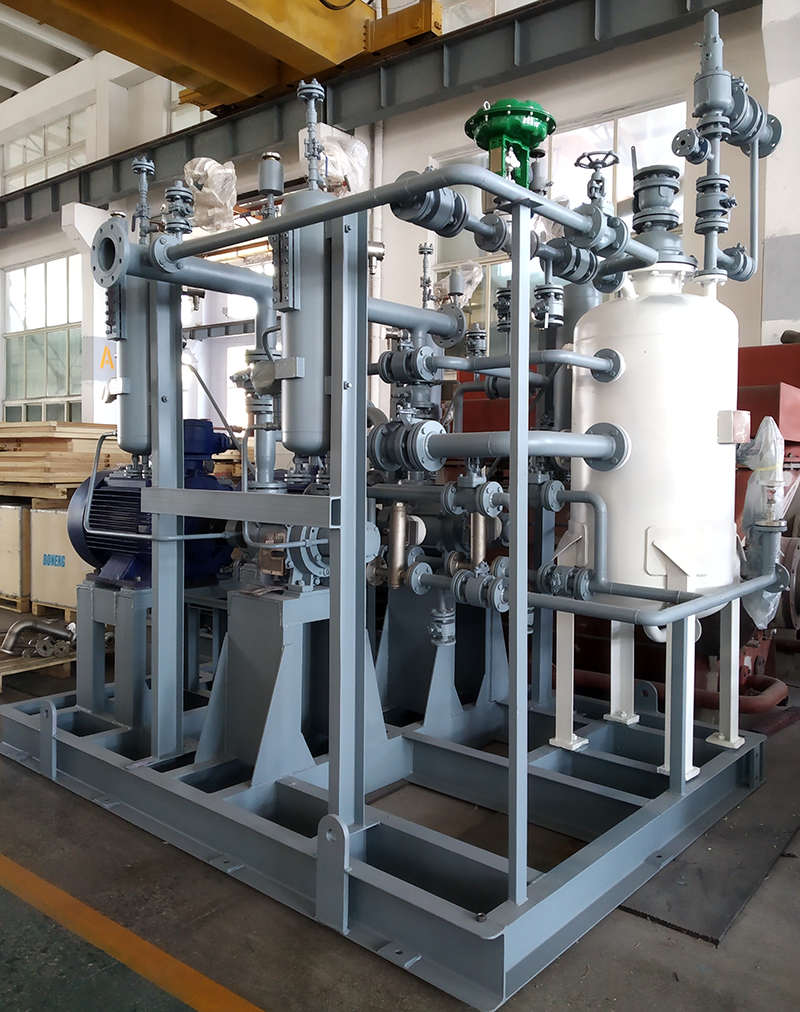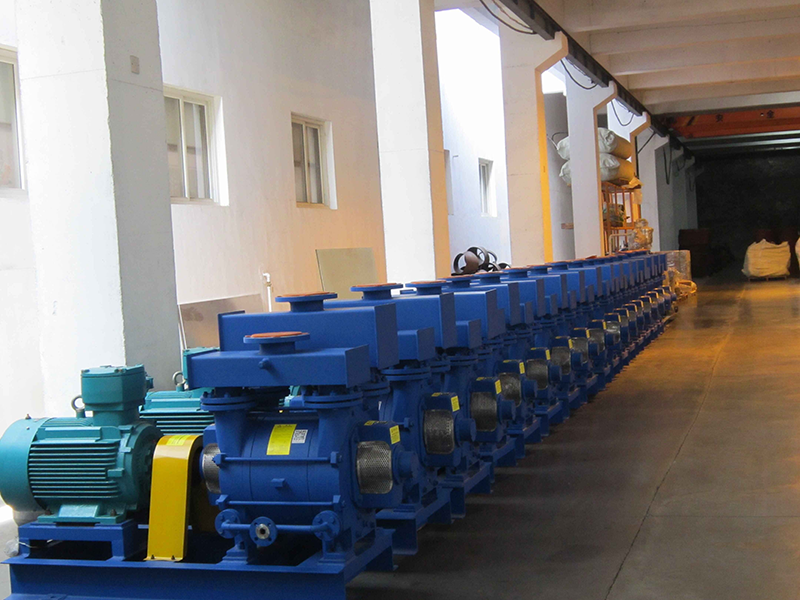Gas Transport and Recovery
Technical Principles
Liquid ring vacuum pumps/compressors consist of an eccentrically mounted rotor inside a casing partially filled with a seal liquid (usually water or compatible fluid). As the rotor spins, its blades are immersed in the liquid, and the centrifugal force creates a stable liquid ring that seals a series of chambers whose volume changes with rotation. Gas is drawn into these chambers and compressed as their volume decreases, then discharged through the outlet. The compression is nearly isothermal, so the gas temperature rises only slightly (typically about 10–15°C), minimizing ignition risk. Moreover, the pump’s simple design with no metal-to-metal contact and no need for flammable lubricants makes it inherently safe for handling flammable, explosive or corrosive gases such as hydrogen and chlorine.
Liquid ring vacuum pumps and compressors share essentially the same construction. In practice, a liquid ring pump is used for vacuum/low-pressure extraction (drawing gas into the pump), while a liquid ring compressor raises the pressure of the gas to deliver it into a high-pressure system. Both types are robust, reliable and require minimal maintenance.
Process Flow Diagram Explanation
In a typical process (e.g. chlor-alkali), an electrolyzer decomposes purified brine, producing hydrogen at the cathode and chlorine at the anode. The reaction is: 2NaCl + 2H₂O → Cl₂ + 2NaOH + H₂. The wet gas products (H₂ and Cl₂) first pass through gas–liquid separators, where they are separated from the caustic liquor and moisture.
A downstream liquid-ring pump system (often a vacuum pump or blower) then draws the gas out of the electrolyzer/separator at controlled low pressure, preventing gas escape. The gas is fed into compressors: typically liquid-ring compressors raise the pressure of both hydrogen and chlorine in one or more stages to the levels required for the next steps. For example, in some chlor-alkali plants the compressed Cl₂ and H₂ are reacted to produce hydrochloric acid (HCl), or the chlorine is further dried and cooled for liquefaction.
After compression, the gas enters condensers to remove heat and residual moisture. Chlorine gas can be cooled to its liquefaction temperature (around –30°C) for safe storage. Hydrogen, after cooling, is typically stored in buffer tanks or fed directly to downstream processes. The buffer tanks stabilize pressure and decouple flow, ensuring continuous supply and smoothing out fluctuations. Throughout this flow, liquid-ring pumps and compressors excel at handling gases containing steam or particulates, making them well-suited for continuous, automated operations.
Technical Advantages
Near-isothermal compression: By using the liquid ring as a coolant, liquid-ring compressors achieve nearly isothermal compression, with exhaust gas only about 10–15°C above intake. This very low temperature rise greatly reduces the risk of heat-induced ignition in flammable gases like H₂ or Cl₂.
Corrosion-resistant & versatile: The liquid seal in a liquid-ring pump effectively protects against corrosive gases (e.g. chlorine), protecting internal parts. Its design tolerates water vapor, condensate, or fine particulates in the gas without needing separate drying or filtering. This versatility allows stable operation even with humid or dirty gas streams.
Simple structure & low maintenance: A liquid-ring pump has only one moving part – the rotor – and no metal-to-metal contact, no lubrication needed and minimal wear. The fluid ring also self-adjusts to seal clearances, reducing wear and maintenance. Compared to reciprocating or screw compressors, the liquid-ring design is simpler and less prone to failure.
High safety: With no internal sparks and the fluid ring buffering pressure surges, liquid-ring pumps enhance safety. The seal liquid’s cooling effect also suppresses temperature spikes during compression. These features make liquid-ring equipment especially suitable for applications with very high safety requirements (e.g. explosive atmospheres or unmanned operation.
Low noise & vibration: Liquid-ring pumps run smoothly, with much lower vibration and noise than many conventional compressors, improving the work environment and reducing foundation requirements.
Industry Applications
Petrochemical
Used in oil & gas plants for waste gas recovery and transport. Typical applications include flare gas recovery in oil fields and refinery off-gas treatment. The ability to handle moist or dirty gas with inherent explosion safety makes them ideal for continuous operation in demanding environments.
Chlor-Alkali
In chlor-alkali plants, large volumes of Cl₂ and H₂ are produced. These gases must be safely extracted, compressed and sent to downstream units (e.g. for HCl or PVC production). Liquid-ring pumps/compressors, being corrosion-resistant and reliable in explosive atmospheres, are widely used for this purpose.
PVC
In PVC production, by-product gases (e.g. hydrogen chloride) must be recovered. Liquid-ring compressors are commonly used to compress HCl-containing waste gas, which can then be condensed into hydrochloric acid or recycled back into the process.
Exhaust Gas Recovery
In industrial exhaust recovery (e.g. landfill gas, chemical plant off-gas), liquid-ring pumps are used to compress and transport steam-containing or acidic gas streams. For instance, combustible gases or organic vapors can be recovered using liquid-ring compressors.
Coal Mine Gas Drainage
Water-ring vacuum pumps are core for safe extraction of methane and similar flammable gases in coal mines. In underground and surface gas drainage, water-ring pumps maintain the required suction, drawing out the methane to treatment or venting units without risking spark ignition.
Natural Gas Recovery
Liquid-ring compressors are also used for medium-/low-pressure recovery of natural gas and biogas. Applications include associated gas from oilfields, refinery plant gases, and city gas station off-gas. Efficient compression and reuse reduces methane emissions and improves fuel utilization.



